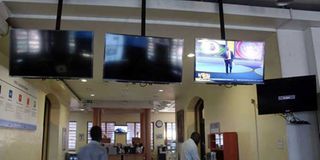Threats, attacks to blame for drop in media freedom: report

Blank screens of leading television stations NTV, Citizen and KTN and a live K24 one in the Nation newsroom on January 30, 2018. Media Council of Kenya CEO David Omwoyo said on May 2, 2018 that media freedom has declined in the past year owing to threats, intimidation and attacks on journalists.
PHOTO | FILE | NATION MEDIA GROUP
What you need to know:
He said a recent study found that 80 per cent of journalists in Kenya were freelancers.
Kenya fell one place in the latest World Press Freedom Index ranking from position 95 to 96.
Another study published in 2015 by media scholar Kioko Ireri showed 61.8 per cent of journalists were unhappy with their monthly income.
Kenya is yet to develop a national media policy to guide the industry and define its relationship with the government and citizens.
Media Council of Kenya chief executive officer David Omwoyo said this on Wednesday in the wake of revelations that media freedom has declined in the past one year owing to threats, intimidation and attacks on journalists by security forces, politicians and hired goons.
The country fell one place in the latest World Press Freedom Index ranking released by Reporters Without Borders (RSF) last month, from position 95 to 96.
“This has been attributed to routine attacks, intimidation and threats that journalists received during the year from security forces, politicians and their supporters due to coverage related to the 2017 General Election.
MEDIA FREEDOM
“These developments do not augur well for media freedom, and especially for the ability of media practitioners to perform their duties,” said Mr Omwoyo ahead of the marking of World Press Freedom Day today in Accra, Ghana. This is the first time the global commemoration fete is being held in Africa.
Mr Omwoyo said media independence – which includes autonomy of media professionals from political, commercial and other interests in editorial decisions and coverage – in Kenya is still a mirage despite media freedom being anchored in various laws such as the Constitution, Media Council of Kenya Act, 2013, Kenya Information and Communication Act (2013) and Freedom of Information Act (2016).
“The legal environment for media in Kenya is anchored in the Constitution under articles 34, 35 and 36,” he said.
MEDIA PLURALISM
The MCK boss also criticised the formation of the Government Advertising Agency (GAA), as the sole media buying agency for the public sector, saying this is an affront to media independence, given that the public sector comprising ministries, departments, agencies, universities and other enterprises is one of the largest spenders on advertising.
He added that the development has resulted in a change in the way newsrooms operate, relying more on freelance journalists and correspondents who are paid less than staff journalists. He said there was a harsh economic environment and declining media revenues.
“This has had a negative effect on the quality of stories because freelancers and correspondents may not give sufficient time to stories due to the “pay-per-article” model,” said the MCK boss.
FREELANCERS
He said a recent study found that 80 per cent of journalists in Kenya were freelancers.
Another study published in 2015 by media scholar Kioko Ireri showed that 83 per cent of journalists were satisfied with their current jobs while 61.8 per cent were unhappy with their monthly income, which ranges from Sh37,500 to Sh62,500.
He added that media pluralism is yet to be achieved, noting that the estimated 179 radio stations, 60 television stations and over 60 print publications in Kenya were controlled by only six players – mainly influential families.
“Elections bring to the fore the effects of ethnicity in newsrooms,” he said.





